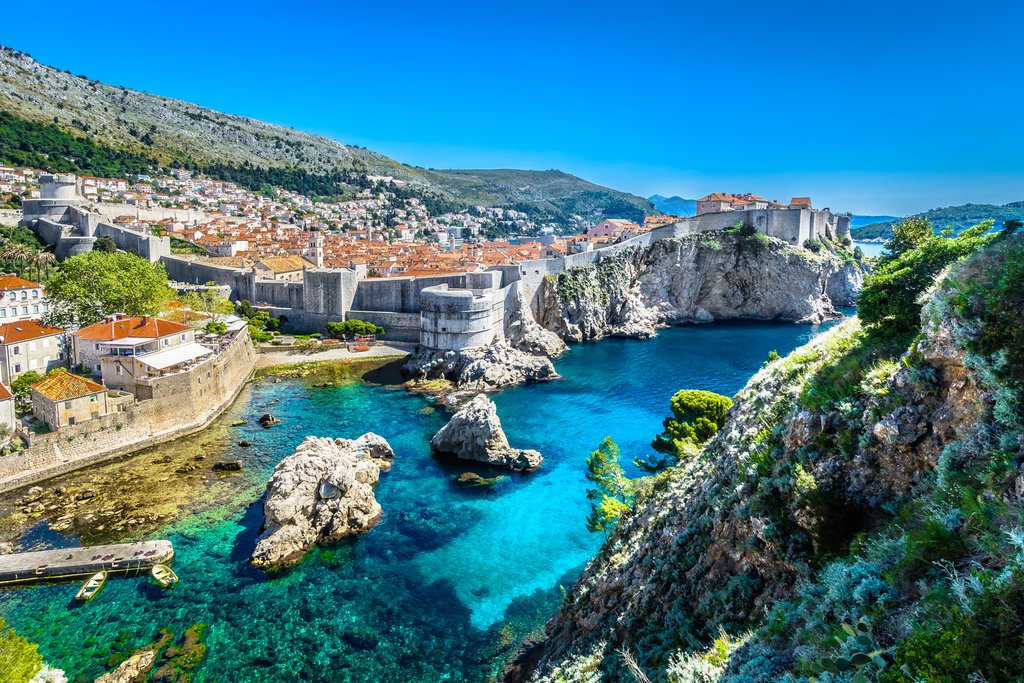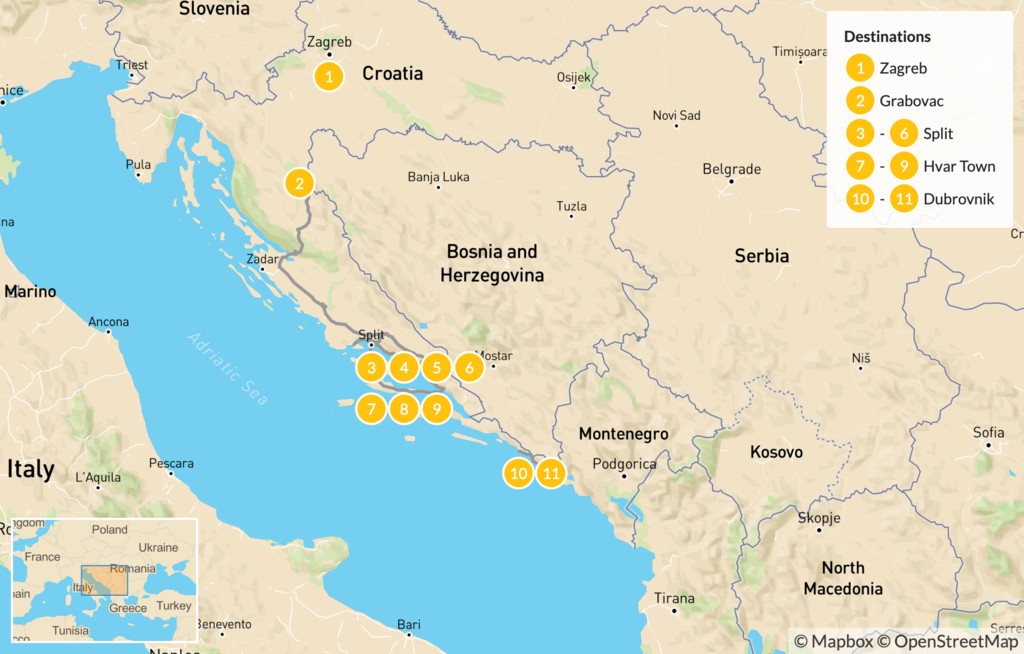Highlights
- Swim in the lagoons of Krka National Park
- Prepare a traditional Croatian meal in Trogir
- Zip-line over the Cetina River Canyon
- Go for a wine tasting at award-winning vineyards on Hvar
- Kayak the coves of Lokrum Island
Brief Itinerary
| Day | Highlights | Overnight |
|---|---|---|
| Day 1 | Welcome to Zagreb! | Zagreb |
| Day 2 | Free Day to Relax in Grabovac Resort (Plitvice Lakes) | Grabovac |
| Day 3 | Plitvice Lakes National Park | Split |
| Day 4 | Plitvice Lakes to Split, Stopping at Krka National Park | Split |
| Day 5 | Cooking Class in Trogir (Day Trip from Split) | Split |
| Day 6 | Rafting, Zip-lining, & Canyoning on the Cetina River | Split |
| Day 7 | Ferry from Split to Hvar | Hvar Town |
| Day 8 | Hvar Offroad Tour | Hvar Town |
| Day 9 | Hvar Wine Tasting | Hvar Town |
| Day 10 | Ferry from Hvar to Dubrovnik | Dubrovnik |
| Day 11 | Walking Tour of Dubrovnik, Sea Kayaking around Lokrum Island | Dubrovnik |
| Day 12 | Depart Dubrovnik |
Detailed Itinerary
Day 1: Welcome to Zagreb!

Start your adventure from Zagreb, the capital of Croatia. Upon arrival at the airport, you'll transfer to your hotel to settle in and you'll have the rest of the day to spend as you like. The city center is easily walkable and the streets and parks are easy to navigate by foot.
Zagreb is at once historic and new. It's filled with leafy green parks and gothic/neo-renaissance buildings, yet there are also modern shopping complexes, outdoor malls, and endless dining and drinking options. Consider heading out on a guided walking tour of the historic heart of the city. This involves walking from Ban Jelačić, the main square, to Zagreb's Upper Town and passing through local markets before reaching St. Mark's Square.
Alternatively, you can visit one of the many museums and art galleries, like the Homeland War Museum, the Nikola Tesla Technical Museum, or the ever-popular Museum of Broken Hearts. Or stroll through the city center, enjoying 17th-century neo-baroque architecture found at Zagreb's Art Pavilion and Croatian National Theater. Zagreb also has a number of beautiful city parks which are great for exploring and people watching, especially in the late afternoon. Maksimir is a great option, with a variety of cafés nearby to pick up a coffee for your stroll.
Day 2: Free Day to Relax in Grabovac Resort (Plitvice Lakes)

Relax and enjoy the natural surroundings of a resort close to Plitvice Lakes National Park. Surrounded by tall pine trees and rolling hills, Resort Tourist Grabovac is bucket list-worthy stop. The distinctive design provides a perfect opportunity to reconnect with nature and the beautiful surroundings by providing you with elegant comfort and rejuvenation. It's the perfect start to experiencing the stunning emerald lakes and cascading waterfalls.
Day 3: Plitvice Lakes National Park

After breakfast, it is time to make your way to Plitvice Lakes National Park, one of Croatia's natural wonders and a UNESCO World Heritage Site. You can enjoy your walk through the national park by yourself or request a private local guide who will take you directly to some of the most exciting sights and give more information and history.
After a lunch break, you will have more time to explore the lakes and drive back to the resort afterward. Relax in your treehouse before continuing your journey to the next stop in the morning.
Day 4: Plitvice Lakes to Split, Stopping at Krka National Park
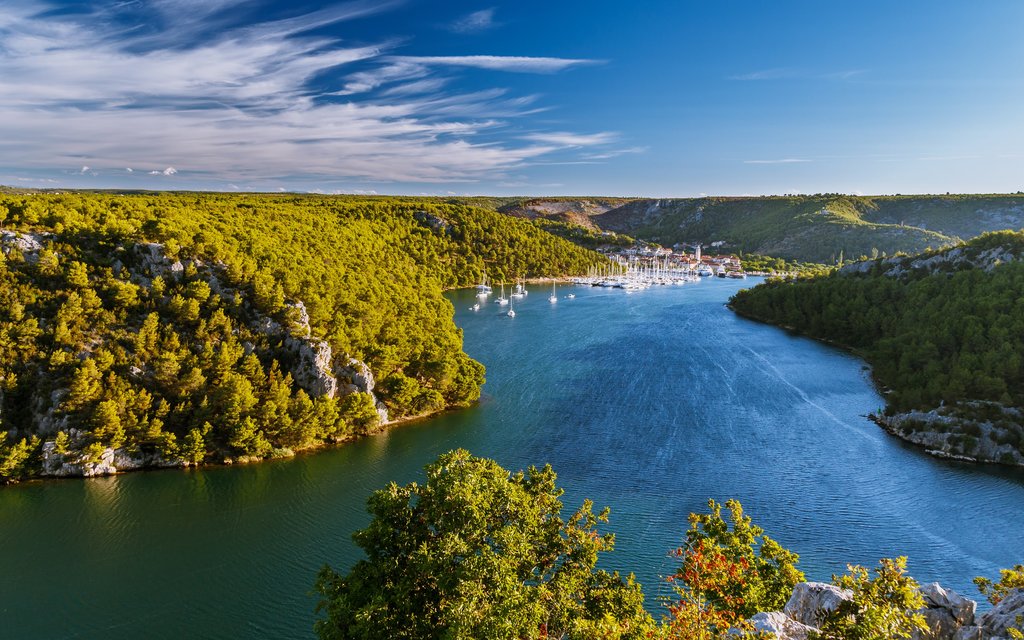
Get an early start to your morning and make the trip south to Krka National Park, another of Croatia's top-rated parks home to a network of striking waterfalls. With seven waterfalls—the largest and most impressive being Skradinski Buk—Krka National Park is one of eight national parks in Croatia. The Krka River, another highlight of the park, carves through the limestone and creates a spectacular canyon on its 44-mile journey (70 km) from the foothills of the Dinaric Alps to Šibenik.
Follow the winding wooden paths that traverse emerald pools and river islands to prime lookout spots in which to view the falls. As if the stunning beauty of these falls isn't enough, you'll also be able to take a dip in one of the lagoons as Krka is the only national park in Croatia where swimming is allowed. Skradinski Buk is the final of the seven waterfalls, and mother nature saved the best for last. Cascading 78 feet (24 m) down into an emerald lagoon wider than the falls are tall, you'll find restaurants, snack stands, and ice cream shops at the base of this postcard locale to satisfy any food-related cravings.
Come mid-afternoon, travel further south to Split, settling into your hotel before taking the rest of the afternoon to wander its historic center. Start at Pjaca Square for pretty views of white marble tiles, the Iron Gate (the western entrance to Diocletian's Palace), a Romanesque clock tower with the remains of a medieval sundial, and the 15th-century Town Hall. Stop for lunch at Trattoria Bajamont, just north of the Iron Gate. From there, visit the popular Voćni trg or Fruit Square. Here you can enjoy renaissance architecture, influenced during Split's Venetian era. For a bit of shopping and a bite to eat head to Marmont Street, though you'll want to make your way to the waterfront to catch the sunset.
In the evening, take a stroll along Split's seafront Riva to admire the views over the Adriatic before finding the off-beat Konoba Dioklecijan restaurant, just to the left of the Bronze Gate for dinner, its outdoor terrace built into the walls of Diocletian's Palace.
Day 5: Cooking Class in Trogir (Day Trip from Split)

Located 45 minutes west of Split is the UNESCO World Heritage Site of Trogir, a port town on a small island just off the mainland. Encircled by medieval walls, Trogir's gorgeous Old Town is a mix of romanesque and neoclassical architecture, making it a romantic destination on any Croatian vacation itinerary. Moreover, the town's location in the heart of the Dalmatian coast makes it the perfect spot to take a cooking class, learn the secrets of the region's delicious cuisine, and enjoy a traditional Croatian gozba (feast).
This half-day culinary adventure begins by meeting your host and cooking instructor and planning a menu according to your food preferences. Then you'll hit Trogir's cobbled streets and browse the markets for the freshest produce. With ingredients in hand, you'll head to the kitchen and start preparing the meal. At the end of the experience, you'll sit down with your host and enjoy the fruits of your labor, together with a glass of one of Croatia's famous wines.
Day 6: Rafting, Zip-lining, & Canyoning on the Cetina River

You'll get an early start this morning to drive south along the coast to Zadvarje for a day of rafting and canyoning the Cetina River, ending with the option to zip-line in Omiš.
You'll begin with rafting in a protected area of the river canyon popular with tourists every summer. The quiet parts of the river, as well as the second and third-grade rapids, create the perfect combination of relaxation with high-adrenaline adventure over the course of three hours. Next, you'll meet your guide and change into your gear (wetsuit, life vest, and helmet) to hike, climb, slide, swim, and cliff jump (optional) your way down the river until you reach Omiš. Celebrate the fun with a break for lunch, before taking the early afternoon to zip-line over the Cetina.
After lunch, you'll experience a true adrenaline rush with the chance to zip your way across the magnificent Cetina River Canyon. There are eight wires in total running a length of 6,890 feet (2,100 m), the highest wire reaching 492 feet (150 m) above the river canyon. Enjoy incredible bird’s eye views of the surrounding scenery on this three-hour excursion.
After the tour is complete, you'll transfer back to Split.
Day 7: Ferry from Split to Hvar
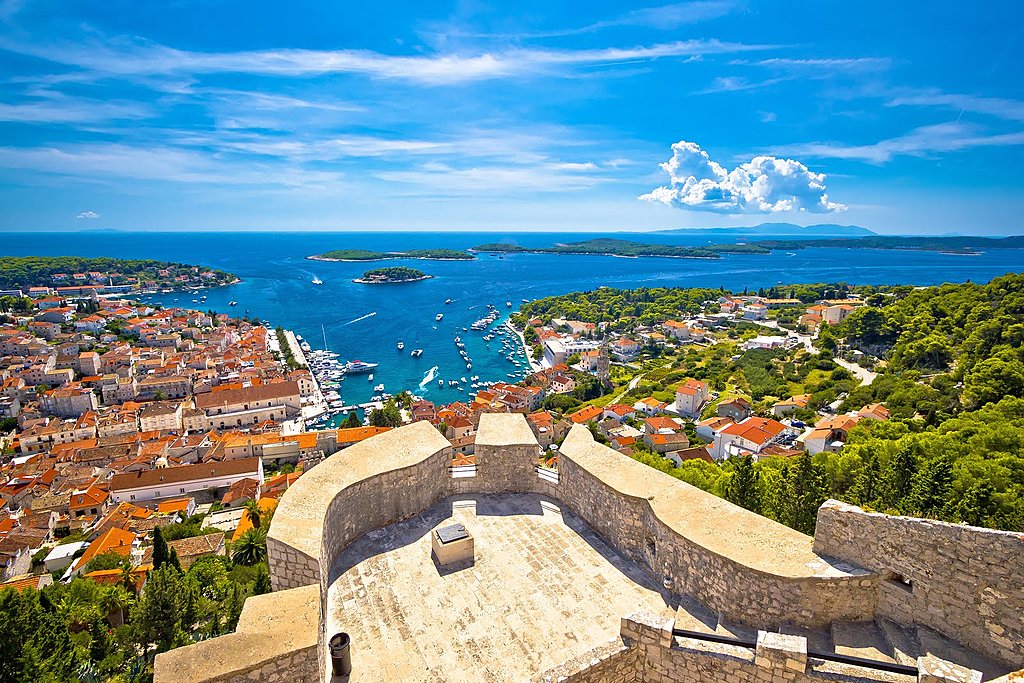
After an easy morning in Split, catch the ferry to the island of Hvar and check into your hotel. A Croatian island in the Adriatic Sea, Hvar is a popular destination with tourists due to its natural setting, mild climate, and its historic port town of the same name. Highlights of Hvar Town include its 13th-century walls, a hilltop fortress, and the main square anchored by the Renaissance-era Cathedral.
For some of the best views of the island, Hvar Town, and the nearby Pakleni Islands take a short walk up to the 16th-century Španjola Fortress. Or, join a kayaking tour and head out on the Adriatic to discover the many secluded coves that outline the islands. To cover some ground and appreciate the variation in island landscape: from lavender plantations and olive groves to vineyards and pine woods, you may like to join a (wine tasting) cycling or hiking tour. The less active might opt to rent a scooter for faster coverage of the local scenery.
After the day's adventures, treat yourself to a drink in the ancient piazza of Hvar overlooking the Venetian loggia, 7th-century fortification walls, and the oldest municipal theater in Europe.
Day 8: Hvar Offroad Tour

Enjoy a full day of guided offroading fun as you cover the undulating island terrain, accented with vineyard-covered hills, thick olive groves, and fragrant fields full of rosemary and lavender. Set out from Hvar Town along a dirt road to the abandoned 16th-century village of Malo Grablje before carrying on to the slightly older, UNESCO-protected Velo Grablje. Once home to a thriving lavender industry, Velo Grablje is slowly undergoing a revival. Today, only a few people inhabit the village throughout the year, but many gather for the annual lavender festival.
Stop for an authentic lunch at a family-run tavern where your meal is traditionally prepared using locally sourced ingredients and the peka, a bell-shaped lid that is covered in coal. Next, you'll spend a little time relaxing on Soline beach on the northern coast of the island near Vrboska before it's time to head up Vidikovac for views over the Stari Grad Plain, an agricultural landscape that was first colonized by the Greeks and is still maintained today, as well as Stari Grad itself, Croatia's oldest township.
After a moment to absorb the breathtaking surroundings, you'll ascend Hvar's tallest peak, St. Nicholas for additional sweeping vistas over the Adriatic and neighboring islands like Brač, Korčula, and Vis and possibly even the east coast of Italy! On your way down the sloping hillside lies Sveta Nedija, a village surrounded by vineyards so steep they’re renowned the world over for being extraordinarily difficult to tend; but they're also known for the high-quality red wine they produce from the Dalmatian plavac grape. Continue along the southern edge of Hvar as you make your way back to your accommodation.
Day 9: Hvar Wine Tasting

Join a half-day wine tour to sample some of Croatia's best wines. Immerse yourself in wine country, less than half an hour inland from Hvar Town, and tour wineries meeting winemakers and exploring UNESCO-protected vineyards where grapes have grown since the time of the ancient Greeks. Hvar's fertile rich soil produces the rich Plavac Mali red, grown both locally and on the Dalmatian coast, as well as Bogdanuša, a dry white indigenous to the island.
One of the island's most beloved wineries is Tomić, run by Andro Tomić, a well-known winemaker. A popular stop for travelers, be sure to ask to see the basement which was inspired by the substructures of Diocletian's Palace in Split. Other suggested wineries are Duboković and Plenković.
Day 10: Ferry from Hvar to Dubrovnik
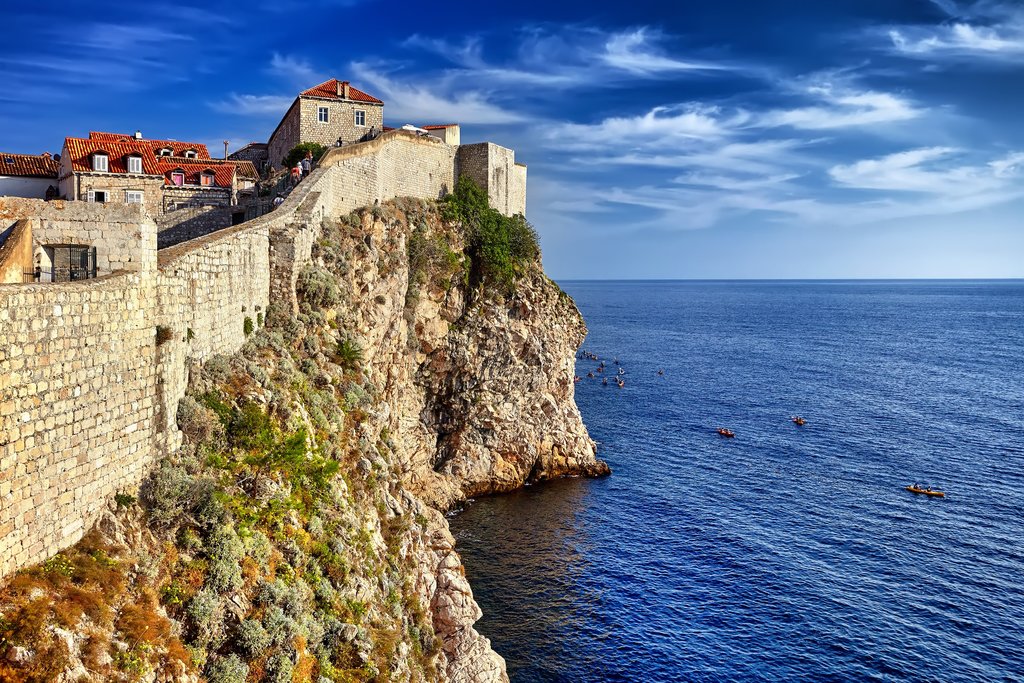
Catch a morning ferry today to Dubrovnik where you will have the day to explore one of the most ancient fortress cities in Europe. Known as the "Pearl of the Adriatic", Dubrovnik is a piece of history. While there's evidence of settlements as far back as the Byzantine era, this area only came into its own in the 12th and 13th centuries when it was under the rule of the Venetians. Throughout the middle ages, it was a fortress port encircled by stone walls and filled with baroque churches and renaissance/gothic palaces that still stand today.
After checking into your hotel, you'll want to get out and explore. Can't-miss activities include riding the cable car up to Srđ Mountain to take in the sunset over the nearby Elafiti Islands, visiting Lovrijenac and Bokar fortresses, and walking along the smooth, limestone-paved streets of historic Old Town. And be sure to find your way to Stradun, Dubrovnik's main street to get your bearings and to choose from a number of excellent restaurants and wine bars. Alternatively, there's Buza Bar along the water's edge and outside the city walls—a great spot to enjoy a cocktail while taking in the sunset.
Day 11: Walking Tour of Dubrovnik, Sea Kayaking around Lokrum Island
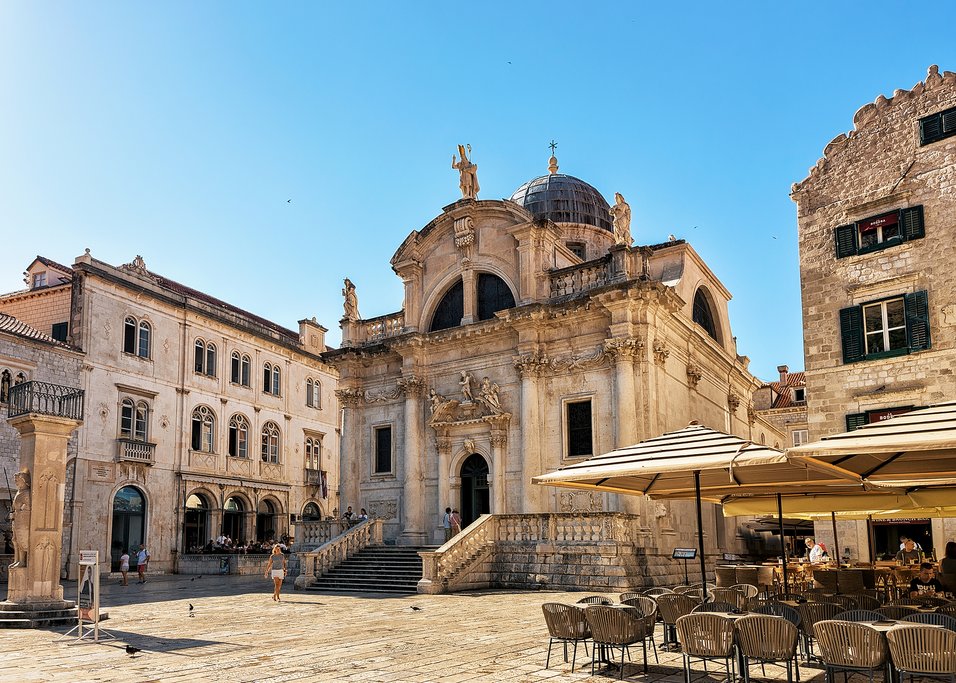
Start your day early (around 8 am) to avoid the crowds and to embark on a tour of Dubrovnik where you'll meet your expert guide outside the entrance to the medieval city at the 16th-century Pile Gate. Entering Old Town, you'll uncover centuries of the city's rich history as you listen to stories of local life and legends and of the importance Dubrovnik once held in the era of the Republic. Highlights include Onofrio's Fountain, the 15th century Rector's Palace, Luza Square, the Church of St. Blaise (St. Vlaho), and the café-lined streets of Brsalje Street.
After touring the streets and alleys, you'll head for Lovrijenac Fortress as well as the city's impressive defensive walls, the second-largest set of city walls in the world. At certain places the wall rises 75 feet high, offering excellent vantage points for photos of the coastline.
In the afternoon, head to the water for a guided kayaking adventure around the city and Lokrum Island—the closest island to Dubrovnik. Starting from Banje Beach, you will paddle to Lokrum Island where you can enjoy a swim in the saltwater lake named the Dead Sea, explore the 15th-century Benedictine monastery, and trek along the car-less trails through overgrown gardens. This is a great way to experience the cultural and historical sites of Dubrovnik from a unique perspective.
Day 12: Depart Dubrovnik

Depending on when you depart, you may have time to visit one of Dubrovnik's museums, like the Franciscan Monastery and Museum. This large complex houses many treasures, including the world's third oldest pharmacy dating from 1317.
Alternatively, for a collection of 15,000 pieces of interesting works, visit the Rector's Palace and Cultural Historical Museum. Wander this well-preserved palace-turned-museum and explore its exhibits, some detailing life in the Republic of Ragusa during medieval times.
The drive to the airport from Dubrovnik takes around 45 minutes with normal traffic.
